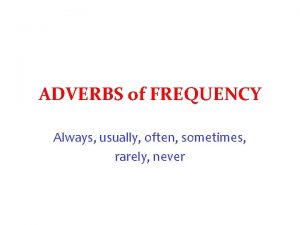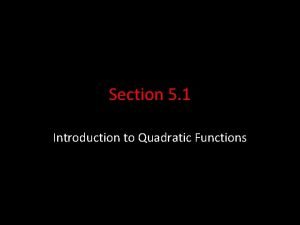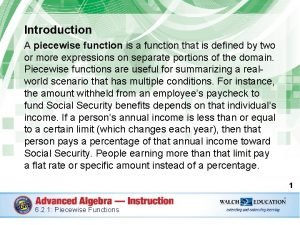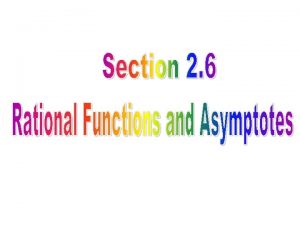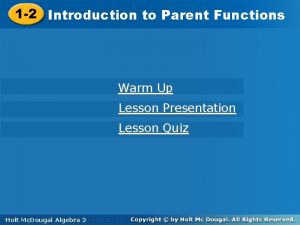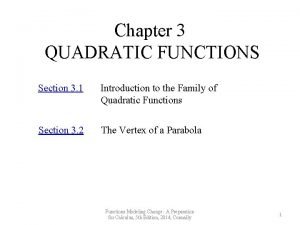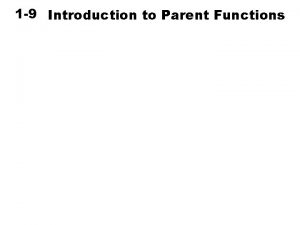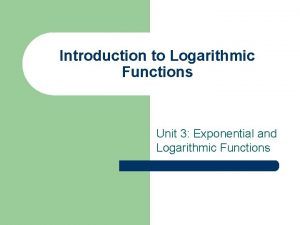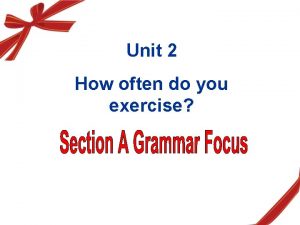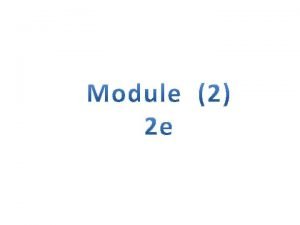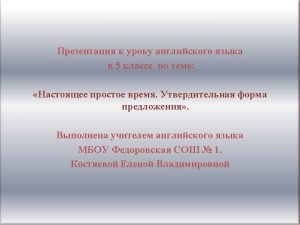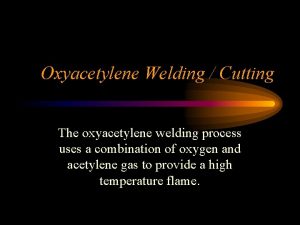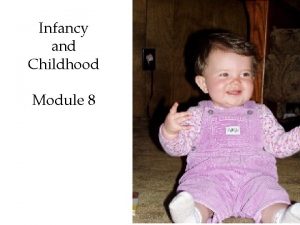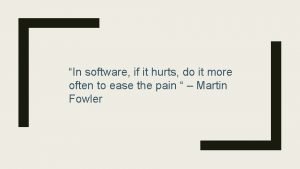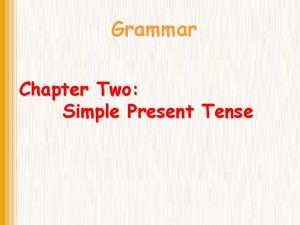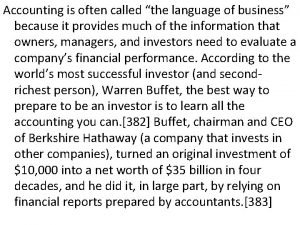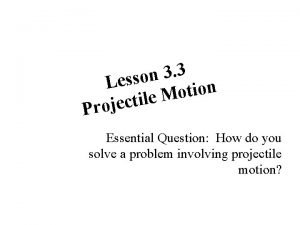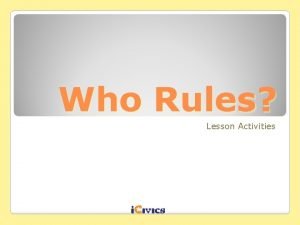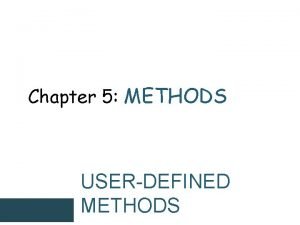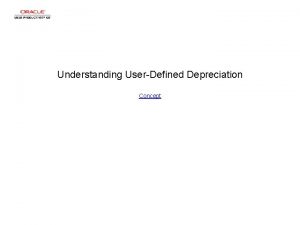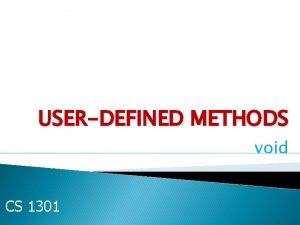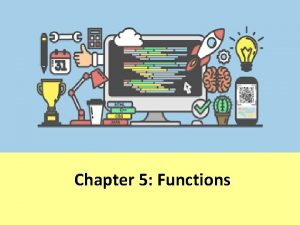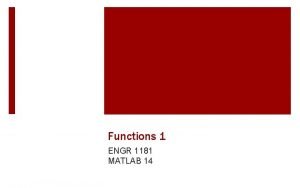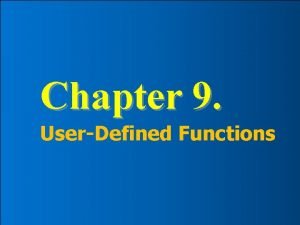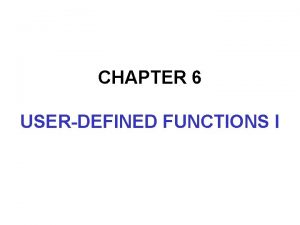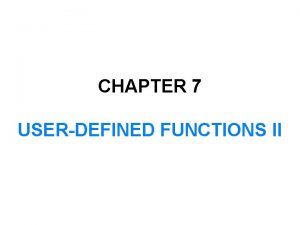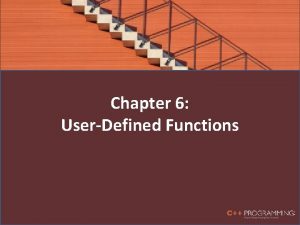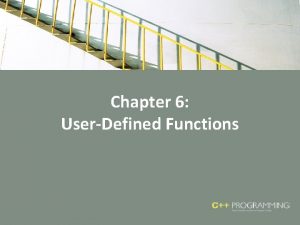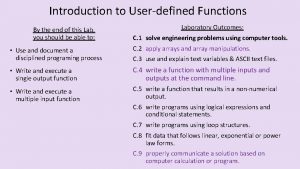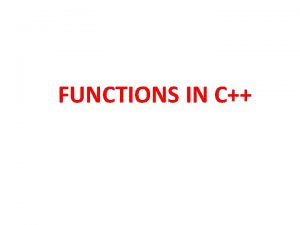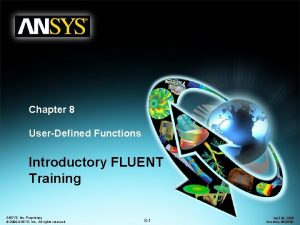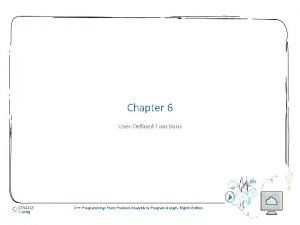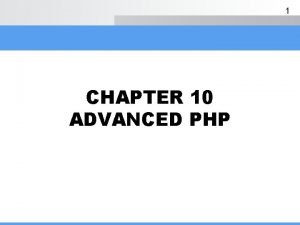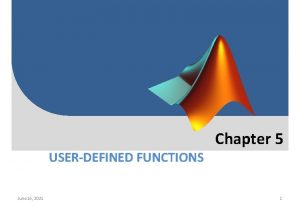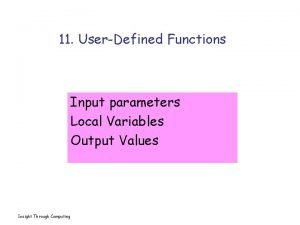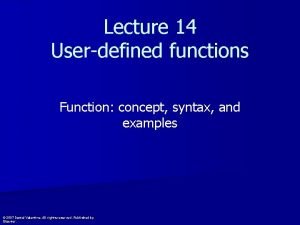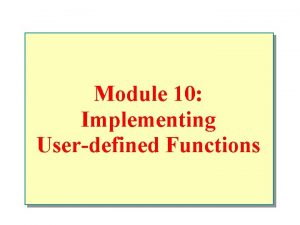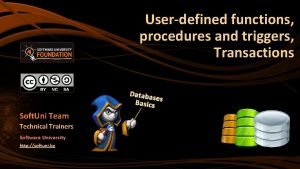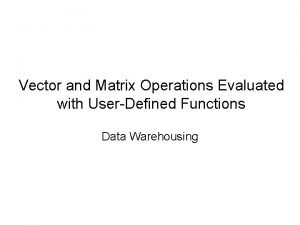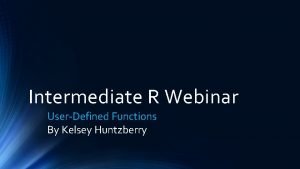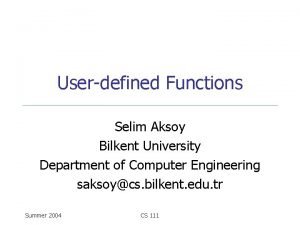Chapter 6 UserDefined Functions Introduction Functions are often
















































- Slides: 48

Chapter 6: User-Defined Functions

Introduction • Functions are often called modules • They are like miniature programs that can be combined to form larger programs • They allow complicated programs to be divided into manageable pieces C++ Programming: Program Design Including Data Structures, Sixth Edition 2

Predefined Functions • In C++, a function is similar to that of a function in algebra – It has a name – It does some computation • Some of the predefined mathematical functions are: sqrt(x) pow(x, y) floor(x) C++ Programming: Program Design Including Data Structures, Sixth Edition 3

Predefined Functions (cont'd. ) • Predefined functions are organized into separate libraries – I/O functions are in iostream header – Math functions are in cmath header • To use predefined functions, you must include the header file using an include statement • See Table 6 -1 in the text for some common predefined functions C++ Programming: Program Design Including Data Structures, Sixth Edition 4

User-Defined Functions • Value-returning functions: have a return type – Return a value of a specific data type using the return statement • Void functions: do not have a return type – Do not use a return statement to return a value C++ Programming: Program Design Including Data Structures, Sixth Edition 5

Value-Returning Functions • To use these functions, you must: – Include the appropriate header file in your program using the include statement – Know the following items: • Name of the function • Number of parameters, if any • Data type of each parameter • Data type of the value returned: called the type of the function C++ Programming: Program Design Including Data Structures, Sixth Edition 6

Value-Returning Functions (cont’d. ) • Can use the value returned by a value-returning function by: – Saving it for further calculation – Using it in some calculation – Printing it • A value-returning function is used in an assignment or in an output statement C++ Programming: Program Design Including Data Structures, Sixth Edition 7

Value-Returning Functions (cont’d. ) • Heading (or function header): first line of the function – Example: int abs(int number) • Formal parameter: variable declared in the heading – Example: number • Actual parameter: variable or expression listed in a call to a function – Example: x = pow(u, v) C++ Programming: Program Design Including Data Structures, Sixth Edition 8

Syntax: Value-Returning Function • Syntax: • function. Type is also called the data type or return type C++ Programming: Program Design Including Data Structures, Sixth Edition 9

Syntax: Formal Parameter List C++ Programming: Program Design Including Data Structures, Sixth Edition 10

Function Call • Syntax to call a value-returning function: C++ Programming: Program Design Including Data Structures, Sixth Edition 11

Syntax: Actual Parameter List • Syntax of the actual parameter list: • Formal parameter list can be empty: • A call to a value-returning function with an empty formal parameter list is: C++ Programming: Program Design Including Data Structures, Sixth Edition 12

return Statement • Function returns its value via the return statement – It passes this value outside the function C++ Programming: Program Design Including Data Structures, Sixth Edition 13

Syntax: return Statement • Syntax: • In C++, return is a reserved word • When a return statement executes – Function immediately terminates – Control goes back to the caller • When a return statement executes in the function main, the program terminates C++ Programming: Program Design Including Data Structures, Sixth Edition 14

Syntax: return Statement (cont’d. ) C++ Programming: Program Design Including Data Structures, Sixth Edition 15

Function Prototype • Function prototype: function heading without the body of the function • Syntax: • Not necessary to specify the variable name in the parameter list • Data type of each parameter must be specified C++ Programming: Program Design Including Data Structures, Sixth Edition 16

Value-Returning Functions: Some Peculiarities C++ Programming: Program Design Including Data Structures, Sixth Edition 17

Value-Returning Functions: Some Peculiarities (cont’d. ) C++ Programming: Program Design Including Data Structures, Sixth Edition 18

Flow of Execution • Execution always begins at the first statement in the function main • Other functions are executed only when called • Function prototypes appear before any function definition – Compiler translates these first • Compiler can then correctly translate a function call C++ Programming: Program Design Including Data Structures, Sixth Edition 19

Flow of Execution (cont’d. ) • Function call transfers control to the first statement in the body of the called function • When the end of a called function is executed, control is passed back to the point immediately following the function call – Function’s returned value replaces the function call statement C++ Programming: Program Design Including Data Structures, Sixth Edition 20

Void Functions • User-defined void functions can be placed either before or after the function main • If user-defined void functions are placed after the function main – The function prototype must be placed before the function main • Void function does not have a return type – return statement without any value is typically used to exit the function early C++ Programming: Program Design Including Data Structures, Sixth Edition 21

Void Functions (cont’d. ) • Formal parameters are optional • A call to a void function is a stand-alone statement • Void function definition syntax: C++ Programming: Program Design Including Data Structures, Sixth Edition 22

Void Functions (cont’d. ) • Formal parameter list syntax: • Function call syntax: • Actual parameter list syntax: C++ Programming: Program Design Including Data Structures, Sixth Edition 23

Void Functions (cont’d. ) • Value parameter: a formal parameter that receives a copy of the content of corresponding actual parameter • Reference parameter: a formal parameter that receives the location (memory address) of the corresponding actual parameter C++ Programming: Program Design Including Data Structures, Sixth Edition 24

Value Parameters • If a formal parameter is a value parameter: – The value of the corresponding actual parameter is copied into it – Formal parameter has its own copy of the data • During program execution – Formal parameter manipulates the data stored in its own memory space C++ Programming: Program Design Including Data Structures, Sixth Edition 25

Reference Variables as Parameters • If a formal parameter is a reference parameter – It receives the memory address of the corresponding actual parameter • During program execution to manipulate data – Changes to formal parameter will change the corresponding actual parameter C++ Programming: Program Design Including Data Structures, Sixth Edition 26

Reference Variables as Parameters (cont'd. ) • Reference parameters are useful in three situations: – Returning more than one value – Changing the actual parameter – When passing the address would save memory space and time C++ Programming: Program Design Including Data Structures, Sixth Edition 27

Value and Reference Parameters and Memory Allocation • When a function is called – Memory for its formal parameters and its local variables is allocated in the function data area • For a value parameter, the actual parameter’s value is copied into the formal parameter’s memory cell – Changes to the formal parameter do not affect the actual parameter’s value C++ Programming: Program Design Including Data Structures, Sixth Edition 28

Value and Reference Parameters and Memory Allocation (cont’d. ) • For a reference parameter, the actual parameter’s address passes to the formal parameter • Both formal and actual parameters refer to the same memory location • During execution, changes made to the formal parameter’s value permanently change the actual parameter’s value C++ Programming: Program Design Including Data Structures, Sixth Edition 29

Reference Parameters and Value. Returning Functions • Can also use reference parameters in a valuereturning function – Not recommended • By definition, a value-returning function returns a single value via return statement • If a function needs to return more than one value, change it to a void function and use reference parameters to return the values C++ Programming: Program Design Including Data Structures, Sixth Edition 30

Scope of an Identifier • Scope of an identifier: where in the program the identifier is accessible • Local identifier: identifiers declared within a function (or block) • Global identifier: identifiers declared outside of every function definition • C++ does not allow nested functions – Definition of one function cannot be included in the body of another function C++ Programming: Program Design Including Data Structures, Sixth Edition 31

Scope of an Identifier (cont’d. ) • Rules when an identifier is accessed: – Global identifiers are accessible by a function or block if: • Declared before function definition • Function name different from identifier • Parameters to the function have different names • All local identifiers have different names C++ Programming: Program Design Including Data Structures, Sixth Edition 32

Scope of an Identifier (cont’d. ) • Rules when an identifier is accessed (cont’d. ): – Nested block • Identifier accessible from declaration to end of block in which it is declared • Within nested blocks if no identifier with same name exists – Scope of function name similar to scope of identifier declared outside any block • i. e. , function name scope = global variable scope C++ Programming: Program Design Including Data Structures, Sixth Edition 33

Scope of an Identifier (cont’d. ) • Some compilers initialize global variables to default values • Scope resolution operator in C++ is : : • By using the scope resolution operator – A global variable declared before the definition of a function (or block) can be accessed by the function (or block) – Even if the function (or block) has an identifier with the same name as the global variable C++ Programming: Program Design Including Data Structures, Sixth Edition 34

Scope of an Identifier (cont’d. ) • To access a global variable declared after the definition of a function, the function must not contain any identifier with the same name – Reserved word extern indicates that a global variable has been declared elsewhere C++ Programming: Program Design Including Data Structures, Sixth Edition 35

Global Variables, Named Constants, and Side Effects • Using global variables causes side effects • A function that uses global variables is not independent • If more than one function uses the same global variable: – Can be difficult to debug problems with it – Problems caused in one area of the program may appear to be from another area • Global named constants have no side effects C++ Programming: Program Design Including Data Structures, Sixth Edition 36

Static and Automatic Variables • Automatic variable: memory is allocated at block entry and deallocated at block exit – By default, variables declared within a block are automatic variables • Static variable: memory remains allocated as long as the program executes – Global variables declared outside of any block are static variables C++ Programming: Program Design Including Data Structures, Sixth Edition 37

Static and Automatic Variables (cont’d. ) • Can declare a static variable within a block by using the reserved word static • Syntax: • Static variables declared within a block are local to the block – Have same scope as any other local identifier in that block C++ Programming: Program Design Including Data Structures, Sixth Edition 38

Debugging: Using Drivers and Stubs • Driver program: separate program used to test a function • When results calculated by one function are needed in another function, use a function stub • Function stub: a function that is not fully coded C++ Programming: Program Design Including Data Structures, Sixth Edition 39

Function Overloading: An Introduction • In a C++ program, several functions can have the same name • Function overloading: creating several functions with the same name • Function signature: the name and formal parameter list of the function – Does not include the return type of the function C++ Programming: Program Design Including Data Structures, Sixth Edition 40

Function Overloading (cont’d. ) • Two functions are said to have different formal parameter lists if both functions have either: – A different number of formal parameters – If the number of formal parameters is the same, but the data type of the formal parameters differs in at least one position • Overloaded functions must have different function signatures C++ Programming: Program Design Including Data Structures, Sixth Edition 41

Function Overloading (cont’d. ) • The parameter list supplied in a call to an overloaded function determines which function is executed C++ Programming: Program Design Including Data Structures, Sixth Edition 42

Functions with Default Parameters • In a function call, the number of actual and formal parameters must be the same – C++ relaxes this condition for functions with default parameters • Can specify the value of a default parameter in the function prototype • If you do not specify the value for a default parameter when calling the function, the default value is used C++ Programming: Program Design Including Data Structures, Sixth Edition 43

Functions with Default Parameters (cont’d. ) • All default parameters must be the rightmost parameters of the function • If a default parameter value is not specified: – You must omit all of the arguments to its right • Default values can be constants, global variables, or function calls • Cannot assign a constant value as a default value to a reference parameter C++ Programming: Program Design Including Data Structures, Sixth Edition 44

Summary • Functions (modules) divide a program into manageable tasks • C++ provides standard, predefined functions • Two types of user-defined functions: valuereturning functions and void functions • Variables defined in a function heading are called formal parameters • Expressions, variables, or constant values in a function call are called actual parameters C++ Programming: Program Design Including Data Structures, Sixth Edition 45

Summary (cont’d. ) • Function heading and the body of the function are called the definition of the function • A value-returning function returns its value via the return statement • A prototype is the function heading without the body of the function • User-defined functions execute only when they are called • Void functions do not have a data type C++ Programming: Program Design Including Data Structures, Sixth Edition 46

Summary (cont’d. ) • Two types of formal parameters: – A value parameter receives a copy of its corresponding actual parameter – A reference parameter receives the memory address of its corresponding actual parameter • Variables declared within a function (or block) are called local variables • Variables declared outside of every function definition (and block) are global variables C++ Programming: Program Design Including Data Structures, Sixth Edition 47

Summary (cont’d. ) • Automatic variable: variable for which memory is allocated on function/block entry and deallocated on function/block exit • Static variable: memory remains allocated throughout the execution of the program • C++ functions can have default parameters C++ Programming: Program Design Including Data Structures, Sixth Edition 48
 Mikael ferm
Mikael ferm Often always usually
Often always usually In literary works cruelty often functions
In literary works cruelty often functions In literary works cruelty often functions
In literary works cruelty often functions Intro paragraph outline
Intro paragraph outline Introduction to quadratic function
Introduction to quadratic function Introduction to piecewise functions
Introduction to piecewise functions Asymptote rules
Asymptote rules 1-2 introduction to parent functions answers
1-2 introduction to parent functions answers Introduction to functions (review game)
Introduction to functions (review game) Calculus 3
Calculus 3 1-2 introduction to parent functions answers
1-2 introduction to parent functions answers Introduction to logarithmic functions
Introduction to logarithmic functions Piecewise function absolute value
Piecewise function absolute value Evaluating functions and operations on functions
Evaluating functions and operations on functions Evaluating functions and operations on functions
Evaluating functions and operations on functions How did postema feel about sexist remarks from spectators
How did postema feel about sexist remarks from spectators Shakespeare is often called
Shakespeare is often called We often go away at weekends
We often go away at weekends How often do you usually do exercise
How often do you usually do exercise Clients often criticize public relations firms for:
Clients often criticize public relations firms for: What is the correct equation for cellular respiration?
What is the correct equation for cellular respiration? Margo and her parents visit visits each other often
Margo and her parents visit visits each other often A sign that alerts you to possible hazards
A sign that alerts you to possible hazards How do new ideas spark change
How do new ideas spark change How often do your homework
How often do your homework Virtual teams are often slowed down by difficulty with:
Virtual teams are often slowed down by difficulty with: Present simple often
Present simple often Personality
Personality Weldequip
Weldequip Characteristics of organizational culture
Characteristics of organizational culture Centrifuge daily maintenance log sheet
Centrifuge daily maintenance log sheet The lorax part 1
The lorax part 1 Smaw unit
Smaw unit Darien's father dictated who darien's friends should be
Darien's father dictated who darien's friends should be If it hurts, do it more often
If it hurts, do it more often How often do you go to restaurant
How often do you go to restaurant Slidetodoc. com
Slidetodoc. com Present simple with always
Present simple with always Cutting force formula
Cutting force formula Emiko's cat often meows for food
Emiko's cat often meows for food Non programmed decision example
Non programmed decision example In alternators the welding current is produced on the ____.
In alternators the welding current is produced on the ____. Accounting is often called the
Accounting is often called the Salmon often jump waterfalls to reach
Salmon often jump waterfalls to reach Undernourished parents often raise
Undernourished parents often raise In the business world people are often measured by their
In the business world people are often measured by their Theocracy can coexist with monarchy true or false
Theocracy can coexist with monarchy true or false A play with an unhappy ending is traditionally called a(n)
A play with an unhappy ending is traditionally called a(n)

